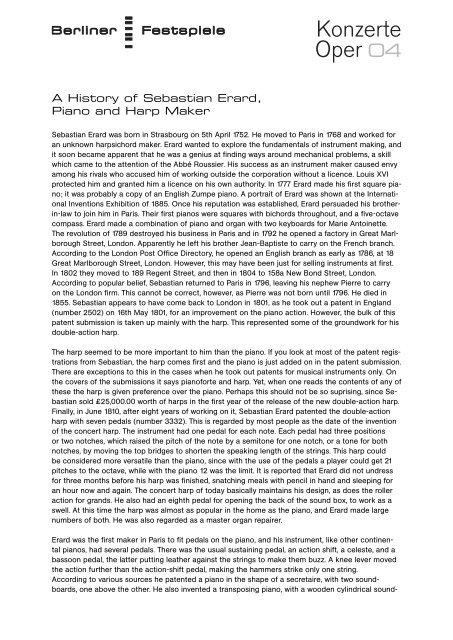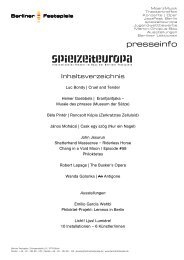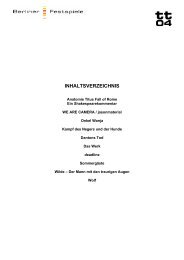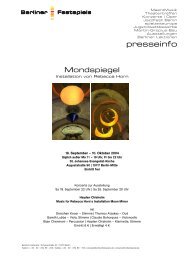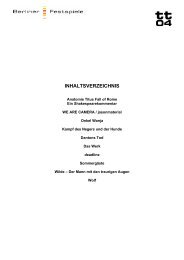konzerte04-pressemappe.pdf - Berliner Festspiele
konzerte04-pressemappe.pdf - Berliner Festspiele
konzerte04-pressemappe.pdf - Berliner Festspiele
Sie wollen auch ein ePaper? Erhöhen Sie die Reichweite Ihrer Titel.
YUMPU macht aus Druck-PDFs automatisch weboptimierte ePaper, die Google liebt.
A History of Sebastian Erard,<br />
Piano and Harp Maker<br />
Sebastian Erard was born in Strasbourg on 5th April 1752. He moved to Paris in 1768 and worked for<br />
an unknown harpsichord maker. Erard wanted to explore the fundamentals of instrument making, and<br />
it soon became apparent that he was a genius at fi nding ways around mechanical problems, a skill<br />
which came to the attention of the Abbé Roussier. His success as an instrument maker caused envy<br />
among his rivals who accused him of working outside the corporation without a licence. Louis XVI<br />
protected him and granted him a licence on his own authority. In 1777 Erard made his fi rst square piano;<br />
it was probably a copy of an English Zumpe piano. A portrait of Erard was shown at the International<br />
Inventions Exhibition of 1885. Once his reputation was established, Erard persuaded his brotherin-law<br />
to join him in Paris. Their fi rst pianos were squares with bichords throughout, and a fi ve-octave<br />
compass. Erard made a combination of piano and organ with two keyboards for Marie Antoinette.<br />
The revolution of 1789 destroyed his business in Paris and in 1792 he opened a factory in Great Marlborough<br />
Street, London. Apparently he left his brother Jean-Baptiste to carry on the French branch.<br />
According to the London Post Offi ce Directory, he opened an English branch as early as 1786, at 18<br />
Great Marlborough Street, London. However, this may have been just for selling instruments at fi rst.<br />
In 1802 they moved to 189 Regent Street, and then in 1804 to 158a New Bond Street, London.<br />
According to popular belief, Sebastian returned to Paris in 1796, leaving his nephew Pierre to carry<br />
on the London fi rm. This cannot be correct, however, as Pierre was not born until 1796. He died in<br />
1855. Sebastian appears to have come back to London in 1801, as he took out a patent in England<br />
(number 2502) on 16th May 1801, for an improvement on the piano action. However, the bulk of this<br />
patent submission is taken up mainly with the harp. This represented some of the groundwork for his<br />
double-action harp.<br />
The harp seemed to be more important to him than the piano. If you look at most of the patent registrations<br />
from Sebastian, the harp comes fi rst and the piano is just added on in the patent submission.<br />
There are exceptions to this in the cases when he took out patents for musical instruments only. On<br />
the covers of the submissions it says pianoforte and harp. Yet, when one reads the contents of any of<br />
these the harp is given preference over the piano. Perhaps this should not be so suprising, since Sebastian<br />
sold £25,000.00 worth of harps in the fi rst year of the release of the new double-action harp.<br />
Finally, in June 1810, after eight years of working on it, Sebastian Erard patented the double-action<br />
harp with seven pedals (number 3332). This is regarded by most people as the date of the invention<br />
of the concert harp. The instrument had one pedal for each note. Each pedal had three positions<br />
or two notches, which raised the pitch of the note by a semitone for one notch, or a tone for both<br />
notches, by moving the top bridges to shorten the speaking length of the strings. This harp could<br />
be considered more versatile than the piano, since with the use of the pedals a player could get 21<br />
pitches to the octave, while with the piano 12 was the limit. It is reported that Erard did not undress<br />
for three months before his harp was fi nished, snatching meals with pencil in hand and sleeping for<br />
an hour now and again. The concert harp of today basically maintains his design, as does the roller<br />
action for grands. He also had an eighth pedal for opening the back of the sound box, to work as a<br />
swell. At this time the harp was almost as popular in the home as the piano, and Erard made large<br />
numbers of both. He was also regarded as a master organ repairer.<br />
Erard was the fi rst maker in Paris to fi t pedals on the piano, and his instrument, like other continental<br />
pianos, had several pedals. There was the usual sustaining pedal, an action shift, a celeste, and a<br />
bassoon pedal, the latter putting leather against the strings to make them buzz. A knee lever moved<br />
the action further than the action-shift pedal, making the hammers strike only one string.<br />
According to various sources he patented a piano in the shape of a secretaire, with two soundboards,<br />
one above the other. He also invented a transposing piano, with a wooden cylindrical sound-


